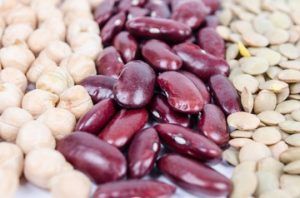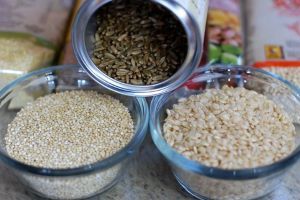High volume low calorie meals:
The struggle to feel satisfied while staying within calorie goals is a familiar one. But what if there was a way to eat until you’re comfortably full without blowing your calorie budget? Enter the concept of high-volume, low-calorie meals. This approach prioritizes foods packed with fiber and water, making you feel fuller for longer with fewer calories consumed.
Why it Works: Science on Your Side
The key to this strategy lies in understanding satiety, the feeling of fullness. Two main factors contribute to satiety: volume and nutrient content. High-volume, low-calorie foods are typically rich in fiber, which takes up space in your stomach and slows down digestion, leading to prolonged feelings of fullness. Additionally, these foods are often lower in fat and sugar, which contribute less to satiety compared to protein and fiber. Studies have shown that meals high in fiber and water are more filling than calorie-dense alternatives, promoting weight management and reducing calorie intake throughout the day [1, 2].
Food Powerhouses:
So, which foods should you focus on? Here are some champions of the high-volume, low-calorie world:
- Vegetables: Leafy greens like spinach, kale, and romaine lettuce, as well as broccoli, cauliflower, and zucchini, are all incredibly low in calories but rich in fiber and water. Aim for at least half your plate to be colorful vegetables at every meal.
- Fruits: Berries, watermelon, cantaloupe, and apples are water-packed and offer natural sweetness to satisfy cravings without added sugars.
- Whole Grains: Quinoa, brown rice, barley, and oats provide sustained energy due to their complex carbohydrates and fiber content. Opt for whole grains over refined options whenever possible.
- Lean Protein: Chicken breast, fish, tofu, and legumes like lentils and chickpeas are excellent sources of protein, which also contributes to satiety. Include a moderate serving of lean protein in most meals.
- Soups and Broths: Broth-based soups with plenty of vegetables are incredibly filling and low in calories. They are also a great way to sneak in extra hydration.
Here are some recipe ideas to get you started
- Spicy Shrimp and Veggie Stir-fry served with Quinoa: This protein-packed stir-fry features loads of colorful vegetables like broccoli, peppers, and carrots, tossed with quinoa for added fiber and served over a bed of steamed spinach.
- Mediterranean Chickpea Salad is served with Pita Bread. Combine chickpeas, cucumber, tomatoes, Kalamata olives, and feta cheese with a light lemon vinaigrette for a protein-rich and flavorful salad. Enjoy with whole-wheat pita bread for dipping.
- Lentil Soup with Winter Greens: This good soup is loaded with protein and fiber from lentils, kale, and carrots, making it an ideal winter hotter.
Experimentation is key! Find combinations you enjoy and customize recipes to your preferences. Don’t forget to explore spices and herbs to add flavor without adding calories.
Sustainable Habits:
While high-volume, low-calorie meals are a powerful tool, remember that healthy eating is an overall lifestyle approach. Here are some additional tips for long-term success:
- Stay hydrated: Drinking plenty of water throughout the day can help curb cravings and contribute to feelings of fullness.
- Practice mindful eating: pay attention to your hunger and fullness cues, and avoid eating mindlessly while distracted.
- Don’t deprive yourself: Allow yourself occasional treats in moderation to avoid feeling restricted and promote sustainable healthy eating habits.
By integrating high-volume, low-calorie dinners into your daily schedule and embracing careful eating rehearses you can accomplish your dietary objectives without feeling denied or continually ravenous. Thus, embrace the force of volume and appreciate nutritious feasts that leave you feeling fulfilled and empowered!

Nutritious diet plan:
When it comes to maximizing nutrient absorption and promoting overall health, the timing of your meals and snacks can be important. Here are some general recommendations for when to eat a healthy diet.

- Breakfast routine: Start your day with a balanced breakfast within a couple of hours of waking up. This meal has to include a combination of carbohydrates, protein, and wholesome fats. It offers the strength you need to kickstart your day and enables you to alter blood sugar stages.
- Regular meal schedule: set up everyday meal instances at some stage in the day. This may help modify your metabolism and save you from immoderate hunger or overeating. purpose to have three primary foods (breakfast, lunch, and dinner) and 1-2 small snacks in between, depending on your character’s wishes.
- Pre- and post-workout nutrition: If you do exercise, keep in mind having a small snack or meal containing carbohydrates and protein before your exercise to offer power and guide muscle recuperation. After your workout, it is important to refill your power stores and support muscle repair with a meal or snack that includes carbohydrates and protein.
- Spacing between meals: allow a gap of around three to four hours between meals to give your body time to digest and soak up vitamins. This can vary depending on your character’s wishes and alternatives. Concentrate on your body’s starvation and fullness cues to determine the exceptional timing of your food.
- Evening meals and control: it is generally recommended to have your dinner some hours earlier than bedtime to permit correct digestion. Keep away from eating heavy food or large portions near bedtime, as it could interfere with sleep.
- Hydration throughout the day: stay hydrated by drinking water constantly throughout the day. it’s high-quality to sip water frequently instead of eating large quantities abruptly. Don’t forget to have water with food and snacks, in addition to food.
Don’t forget, these pointers are widespread hints, and a man or woman’s needs may also range based on factors like pastime stage, fitness situations, and private alternatives. It is crucial to pay attention to your body, honor your starvation and fullness cues, and change your meal timing accordingly. Consulting a healthcare expert or registered dietitian can offer customized steering tailored to your unique needs.

